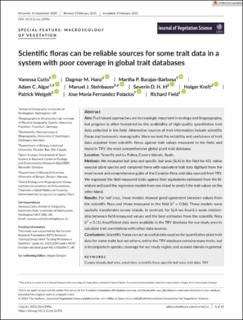| dc.contributor.author | Cutts, Vanessa | |
| dc.contributor.author | Hanz, Dagmar M. | |
| dc.contributor.author | Barajas-Barbosa, Martha P. | |
| dc.contributor.author | Algar, Adam C. | |
| dc.contributor.author | Steinbauer, Manuel | |
| dc.contributor.author | Irl, Severin D.H. | |
| dc.contributor.author | Kreft, Holger | |
| dc.contributor.author | Weigelt, Patrick | |
| dc.contributor.author | Fernández-Palacios, José María | |
| dc.contributor.author | Field, Richard | |
| dc.date.accessioned | 2022-04-07T11:26:44Z | |
| dc.date.available | 2022-04-07T11:26:44Z | |
| dc.date.created | 2022-01-25T16:32:35Z | |
| dc.date.issued | 2021 | |
| dc.identifier.issn | 1100-9233 | |
| dc.identifier.uri | https://hdl.handle.net/11250/2990512 | |
| dc.description.abstract | Aim
Trait-based approaches are increasingly important in ecology and biogeography, but progress is often hampered by the availability of high-quality quantitative trait data collected in the field. Alternative sources of trait information include scientific floras and taxonomic monographs. Here we test the reliability and usefulness of trait data acquired from scientific floras against trait values measured in the field, and those in TRY, the most comprehensive global plant trait database.
Location
Tenerife and La Palma, Canary Islands, Spain.
Methods
We measured leaf area and specific leaf area (SLA) in the field for 451 native vascular plant species and compared them with equivalent trait data digitised from the most recent and comprehensive guide of the Canarian flora, and data sourced from TRY. We regressed the field-measured traits against their equivalents estimated from the literature and used the regression models from one island to predict the trait values on the other island.
Results
For leaf area, linear models showed good agreement between values from the scientific flora and those measured in the field (r2 = 0.86). These models were spatially transferable across islands. In contrast, for SLA we found a weak relationship between field-measured values and the best estimates from the scientific flora (r2 = 0.11). Insufficient data were available in the TRY database for our study area to calculate trait correlations with other data sources.
Conclusions
Scientific floras can act as useful data sources for quantitative plant trait data for some traits but not others, whilst the TRY database contains many traits, but is incomplete in species coverage for our study region, and oceanic islands in general. | en_US |
| dc.language.iso | eng | en_US |
| dc.publisher | Wiley | en_US |
| dc.rights | Navngivelse 4.0 Internasjonal | * |
| dc.rights.uri | http://creativecommons.org/licenses/by/4.0/deed.no | * |
| dc.title | Scientific floras can be reliable sources for some trait data in a system with poor coverage in global trait databases | en_US |
| dc.type | Journal article | en_US |
| dc.type | Peer reviewed | en_US |
| dc.description.version | publishedVersion | en_US |
| dc.rights.holder | Copyright 2021 The Author(s) | en_US |
| dc.source.articlenumber | e12996 | en_US |
| cristin.ispublished | true | |
| cristin.fulltext | original | |
| cristin.qualitycode | 1 | |
| dc.identifier.doi | 10.1111/jvs.12996 | |
| dc.identifier.cristin | 1989787 | |
| dc.source.journal | Journal of Vegetation Science (JVS) | en_US |
| dc.identifier.citation | Journal of Vegetation Science (JVS). 2021, 32(3), e12996. | en_US |
| dc.source.volume | 32 | en_US |
| dc.source.issue | 3 | en_US |

